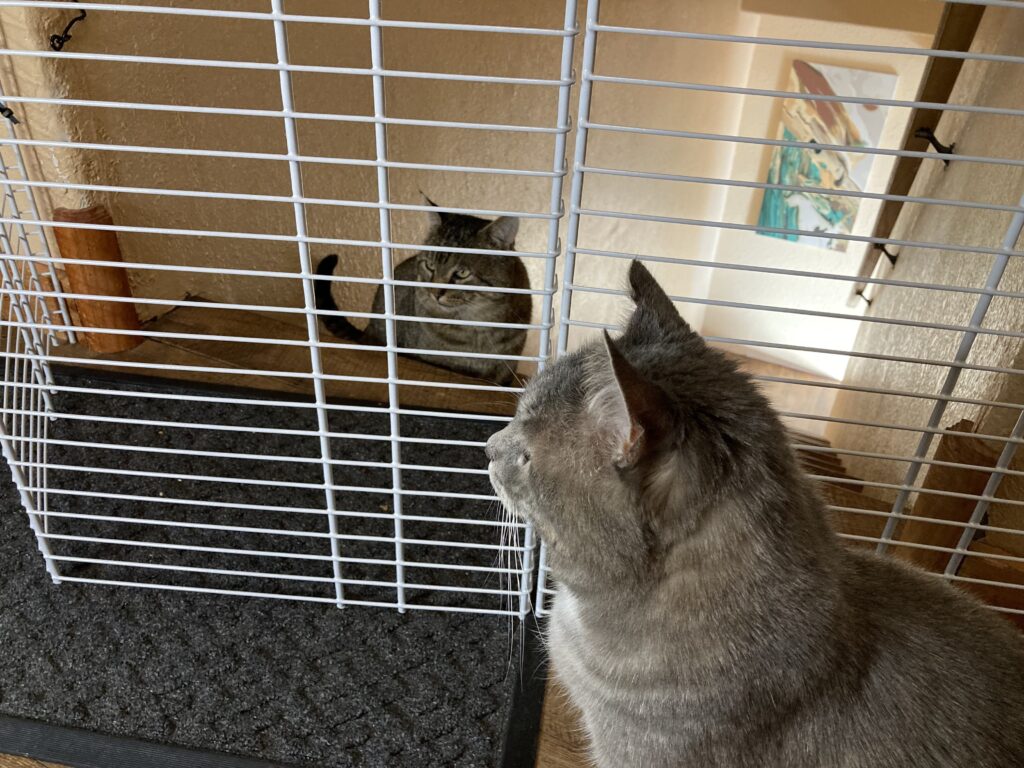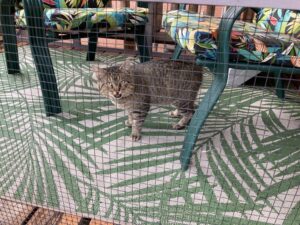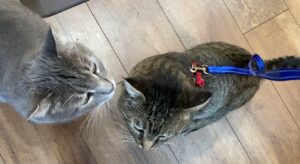 Introducing a new cat to an established group of resident cats can be challenging. Most experts recommend a slow, gradual introduction, similar to how wild cat colonies accept new members.
Introducing a new cat to an established group of resident cats can be challenging. Most experts recommend a slow, gradual introduction, similar to how wild cat colonies accept new members.
introducing a new cat
Wild cats recognize members of their own colony. Unfamiliar cats will be greeted with aggression if they try to approach and enter the group. This is not to say that non-members don’t join the colony from time to time. If these “outsiders” are persistent in their attempts to join the group, they may be accepted after a gradual process that involves many interactions (Reference 1).
I am in the process of introducing a new cat to my household. The introduction process is still ongoing but here is my progress so far.
Miso is 2 year old male domestic shorthair who had been frequenting the porch where my veterinarian employer leaves food out for the community cats. Miso behaved more like a stray cat and tried to get into the house. So, he was coaxed into a carrier, neutered and had dental treatment at the veterinary clinic where I work.
Miso is friendly toward humans and other cats. Although he is quite a bit younger than my cats, I thought it was worth a try to bring him into my group.
At the time of the introduction, there were 4 cats in my household and two social groups:
- Athena, aged 18 years, forms her own social group. She tolerates the other cats but does not snuggle, groom or otherwise interact with them.
- Marley, a 17 year old neutered male, 7 year old Gus, and 7 year old Zelda form the second social group. Zelda and Marley will snuggle together particularly when it is cold. Gus and Zelda allogroom; Gus and Zelda also groom Marley.
Getting Ready

Introducing a new cat starts with scent exchange. A few weeks before I brought Miso home, I brought home a blanket he slept on and left it in the kitchen area. All four cats carefully smelled it and there was some hissing but that waned over a week.
I made a barricade of closet shelving to close off the downstairs from my resident cats and set up a room downstairs for Miso to stay in with a litter box, scratching posts and food station.
Week 1
Miso is calm and confident and asks to go out of his room. He goes out into the catio downstairs. We set up a system of time-sharing the catio, allowing Zelda and Athena to occupy it in the morning while Miso is closed in his room. Miso has the catio in the afternoon. At night, Miso is closed in his room.
Miso chooses to eat at the top of the stairs next to the barricade. The other cats are fed out of sight in the kitchen.
At the end of the week, I apply a mousse shampoo to Miso and wash his bedding, thinking that he might smell like the vet clinic. I also put a multi-cat pheromone diffuser downstairs and 4 more on the upstairs floor.
Week 2 – Zelda gets sick
Zelda has diarrhea which I think may be due to the stress of having a new roommate. The diarrhea resolves with a few days of probiotics.
The resident cats frequently hiss while passing Miso at the barricade but they now ignore him and continue on their way. We start to allow Miso upstairs while the other cats are in the catio.
At the end of the week, we allow Miso to have free run of the downstairs and not be closed in his room at night. The barricade is still up.
Week 3 – A Behavior Change for Gus
Miso was trained to harness and leash when at the vet clinic. I officially bring Miso upstairs on a leash and we have our first friendly interaction with the residents – Miso and Gus touch noses and there is no hissing.

Miso is assigned a feeding station (a cat carrier) to eat in and is fed with the other cats. I get a little push back from Gus, who refuses to eat at his feeding station. I offer him his food on his cat tree which he accepts.
Miso starts doing the evening food puzzle and treat toss with Zelda and Marley. Again, Gus prefers not to participate and does his food puzzles on his cat tree. The barricade is opened during the day near the end of the week.
Week 4 – Aggression from Athena
Athena swats Miso and we separate them temporarily, closing Athena in the bedroom. I put a broom near the door way with the water fountain so that I can herd Miso away in case he blocks Athena on her way to water.

There is still plenty of hissing going on but everyone’s body language is neutral. There are still 4 multi-cat pheromone diffusers on the upper floor. Miso is allowed out in the catio with the other cats. Everyone keeps their distance.
At the end of the week, Miso is allowed upstairs at night and chooses an empty carrier to sleep in.
Although the cats are sharing common areas now, the process of introducing a new cat is far from over. It will take many more months before all the cats are accustomed to the new resident and the changes in the daily routines.
Introducing a new cat into an established household is stressful for the incoming cat as well as the residents. Even with a gradual introduction, stress-induced illness, changes in routine, and displays of aggression are not uncommon. It is important to monitor the body language of all the cats, accommodate changes in behavior and be ready to separate cats if there is a scuffle.
references
- Crowell-Davis SL, Curtis TM, Knowles RJ. Social organization in the cat: a modern understanding. J Feline Med Surg. 2004 Feb;6(1):19-28. doi: 10.1016/j.jfms.2003.09.013. PMID: 15123163.


